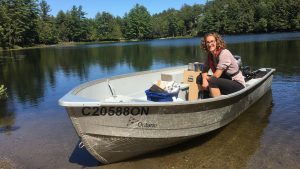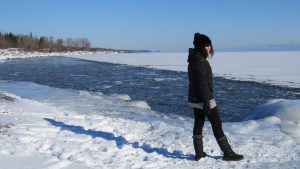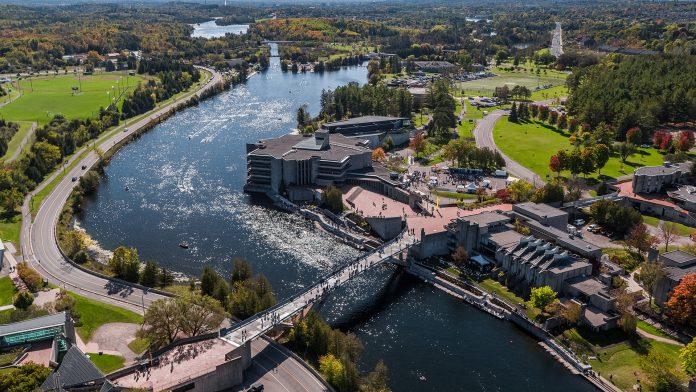Trent University in Ontario is engaged in a range of studies focused on addressing local and global freshwater issues, including microplastics, carbon cycling, and pollution.
Freshwater resources are essential for sustaining life, supporting ecosystems, and providing human needs. Yet, these vital systems all across the globe are increasingly threatened by climate change, pollution, habitat loss, invasive species, and the list goes on.
It might feel like the physical scale of these resources makes these challenges unmanageable, but you just need to look to Canada – one of the world’s largest countries and regarded as a leader in freshwater resource management – to be inspired and optimistic. Specifically, Trent University in Peterborough and Durham GTA, Ontario, is showcasing leadership in the field of freshwater research with its depth and breadth of knowledge, unique resources, and collaborative approach to understanding and informing solutions.
Trent’s top researchers are leaders in water research
Trent University boasts a diverse group of over 30 experts involved in and dedicated to freshwater and environmental research. This distinguished collection of experts consists of Canada Research Chairs, endowed chairs, biologists, hydrologists, ecologists, forensic scientists, chemists and many others with a wide range of knowledge, some even managing multimillion dollar research programmes.
Leading the entire portfolio of research at Trent is Dr Holger Hintelmann, vice president of Research & Innovation and an internationally recognised chemist, who recently led a 20-year international collaboration on mercury pollution in lakes.
Of the nine Canada Research Chairs at Trent University, six are experts in environmental topics and of those, two are focused on freshwater research. Dr Marguerite Xenopoulos, a biology professor at Trent University, is the Canada Research Chair in Global Change of Freshwater Ecosystems. She is not only studying one of North America’s most significant freshwater systems, the Great Lakes, but also an award-winning journal editor. She was recently recognised for efforts to improve global inclusion in science publishing.
Canada Research Chair in Climate Change and Northern Ecosystems, Dr Andrew Tanentzap, studies how northern soils and freshwaters will respond to climate change and what this means for people. Professor Tanentzap is a professor at the Trent School of the Environment, including Trent’s Climate Change Science & Policy programme. He brings his research, which involves the use of advanced and rare mass spectrometry technologies at Trent’s Water Quality Centre, into his teaching and training of highly qualified personnel, offering Trent students the latest insights into the impact of climate change. Prof Tanentzap also joined the Royal Society of Canada in 2023, recognised for his groundbreaking work at the interface between ecology, evolutionary biology, and biogeochemistry.
School of Environment professor and the former Canada Research Chair in Environmental Modelling, Dr Julian Aherne, is currently engaged in research to enhance our understanding of microplastic pollution in freshwater systems around the world and locally.
Like Professor Aherne, many of Trent’s water researchers are engaged in research close to home. Dr Catherine Eimers, associate director of the Trent School of the Environment, monitors water quality in local watersheds in the Kawartha region. An assistant professor of Biology at Trent, Dr Graham Raby leads the Stoney Lake Fish Tracking Project, a flagship study of the Trent Aquatic Research Program (TARP), a programme that also features Dr Paul Frost, the David Schindler Endowed Professor of Aquatic Science at Trent.
Trent’s premier facilities and regional landscape boost water research advantage
While Trent’s leadership in water research is largely driven by faculty expertise, those researchers also benefit from the unique advantages of the University, namely access to advanced instrumentation, as well as geographic and topographic features in proximity to the campus.
Trent University’s location in Peterborough and Durham GTA, Ontario, offers premium access to fresh water, positioning it as a hub for freshwater research and education. Trent is nestled within the Kawartha region, home to about 250 lakes, and sits along the banks of the Otonabee River, part of the Trent-Severn Waterway. The Trent-Severn is a man-made waterway spanning nearly 400 kilometres, linking Georgian Bay in Lake Huron to the Bay of Quinte in Lake Ontario.
Trent is also located adjacent to the Muskoka Region, home to another 1,600 lakes, and at the forefront of freshwater microplastics research. Prof Aherne and Brittany Welsh, an Environmental & Life Sciences PhD candidate at Trent are working in collaboration with Ontario’s Ministry of Environment, Conservation and Parks to better understand the lifecycle of plastic particles in lakes. The team recently uncovered new insights into the pervasiveness and persistence of microplastics, showing they’re remaining in lakes for up to a decade or longer, not just passing through on their way to oceans as previously thought.
On campus, Trent is home to Canada’s leading comprehensive mass spectrometry facility, the Water Quality Centre (WQC), which supports research measuring and analysing trace amounts of organic and inorganic contaminants in water and other environmental compartments. The advanced and, in some cases, rare equipment here attracts top researchers to work at and collaborate with Trent. As the WQC does not reside within any one academic department at Trent, it naturally facilitates multidisciplinary research and expands applications of the instruments by extending its analytical services and training courses to researchers, government agencies, and private companies. It’s another hub for freshwater research and education and is directed by Dr Paul Spzak, a professor in anthropology at Trent and the Canada Research Chair in Environmental Archaeology.
While there are 13 advanced mass spectrometers at the WQC, the Fourier-transform ion cyclotron resonance mass spectrometer (FT-ICR-MS) is one of only three in Canada and is at the centre of Prof Tanentzap’s Canada Research Chair programme. Prof Tanentzap’s work using the multimillion-dollar instrument to analyse the chemical diversity in freshwater samples with extraordinary detail has been published in Science. Through the use of this high-resolution instrument, Prof Tanentzap is building our understanding of the composition of dissolved organic matter (DOM) in freshwater systems, which is made up of thousands of distinct organic compounds, and how DOM has the potential to be a tool for tracking and restoring the health of freshwater systems.
Trent excels at research collaboration
To have the greatest impact, the pursuit of knowledge to better understand the health of local and global freshwater systems must be done collaboratively. Since its early days as a university, Trent has emphasised interdisciplinary research and teaching; working together not only makes better use of resources but also leads to more comprehensive perspectives and solutions.
Spearheading international environmental research consortium
Trent University is a founding member of the International Institute for Environmental Studies (IIES). The IIES fosters collaboration among faculty, students, and trainees, promoting joint research efforts in environmental science, engineering, and policy, and facilitates the sharing of expertise and resources.
Founded in 2015, the institute now features 28 members from countries around the world, including Switzerland, the UK, Korea, Finland, and the US. The initiative underscores Trent’s commitment to addressing global environmental challenges together, but even more so demonstrates the University’s strengths in bringing experts from across the globe together to work on solutions in a variety of different ways.
Global collaboration on microplastic pollution research
Prof Aherne and PhD candidate Brittany Welsh were also part of a global collaboration on microplastics, examining plastic debris in lakes and reservoirs across 23 countries, with the research revealing that freshwater systems can accumulate microplastics as significantly as marine environments. All collaborators used standardised sampling methods, making it possible to compare microplastic concentrations globally and establish a comprehensive picture of contamination across diverse ecosystems. These findings, published in Nature, significantly advanced our understanding of plastic pollution’s prevalence in freshwater environments.

Investigating the Great Lakes at a great pace
Prof Xenopoulos’ work studying global change of freshwater ecosystems involves significant research in the Great Lakes. It is one of North America’s, and perhaps even the world’s, most significant, freshwater systems, which is why Prof Xenopoulos joined the ‘Winter Grab’, a first-of-its-kind collaboration between Canadian universities and US research institutions. Together, researchers are investigating how declining ice cover due to climate change affects water quality and life in and underneath the ice.
The need for winter research is greater than ever as a new record for lowest ice cover on the Great Lakes was set in 2024, following the start of this research in 2022. Bringing 16 institutions together to tackle this rapidly evolving issue means we can work faster, share insights and resources, and ultimately develop a more comprehensive understanding of the consequences of ice cover losses and increasing air and water temperatures, particularly to help inform management decisions.

20 years studying mercury pollution
VP Hintelmann was not the only investigator in the 20-year mercury study. He was part of an international collaboration – the Mercury Experiment to Assess Atmospheric Loading in Canada and the US (METAALICUS) – that worked together over two decades studying mercury pollution. Large-scale and long-term projects like METAALICUS require commitment and patience, but with combined expertise and resources, these projects can also offer the opportunity to employ cutting-edge techniques.
To study the sources, transport, and fate of mercury and heavy metal pollutants in water bodies, the research team monitored tagged mercury isotopes introduced into an experimental watershed system. Specifically, this project took place within the Experimental Lakes Area in northwestern Ontario, the only place in the world where scientists can manipulate real lakes, over the long term, to understand what human activity does to freshwater.
The impressive ecosystem study revealed that in just five to ten years after mercury emissions were cut, mercury concentrations in fish dropped by as much as 76 percent, varying by species and lifespan. Ultimately, this study provided valuable insights into managing pollutants and minimising exposure to mercury pollution to ensure human health.
At home in the Kawarthas
Local partnerships are also core to Trent’s collaborative efforts, ensuring the research activity finds practical applications. Dr Catherine Eimers, associate director of the Trent School of the Environment, has led research teams in monitoring local watersheds in Ontario’s Kawartha region and working alongside local farmers to support adaptations to land management practices to reduce agricultural run-off.
Through the Trent Aquatic Research Program (TARP), researchers from diverse disciplines at Trent work with external partners to tackle local water quality issues. Dr Graham Raby, assistant professor of Biology at Trent, leads the Stoney Lake Fish Tracking Project, a community-driven initiative tagging and tracking fish to inform conservation of fish populations in local lakes, on which many people depend for livelihoods and recreation and for ecosystem management.
Future of freshwater research at Trent
The future of freshwater research relies on collaborative efforts that extend beyond institutional boundaries to engage diverse stakeholders. Trent researchers collaborate with a variety of research partners – academics, community members, governments, non-profits, and more – to ensure that the research findings are relevant, comprehensive, and actionable.
As a place of leading expertise and advanced technologies, Trent University can be a partner that bolsters the work of others in addressing the complex issues facing freshwater systems. Together, we’re developing strategies that enhance aquatic ecosystem resilience, formulating targeted interventions to improve water quality, monitoring and mitigating contamination in Canada’s freshwater resources, and informing water management practices and conservation of natural resources.
We welcome more opportunities to work together to confront the challenges facing freshwater systems around the world.
Please note, this article will also appear in the 20th edition of our quarterly publication.









